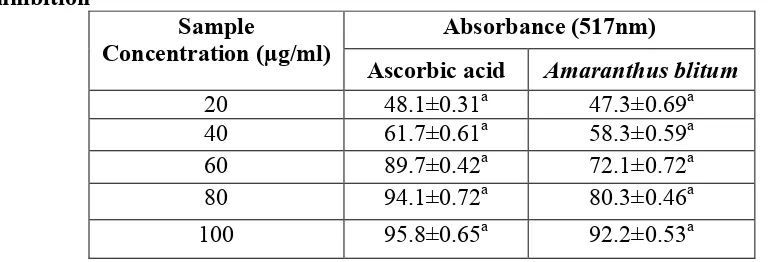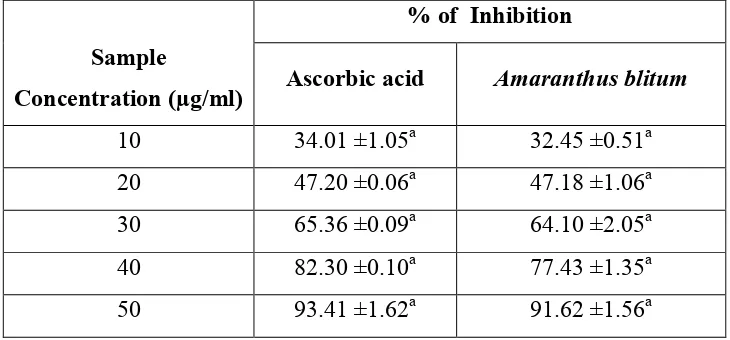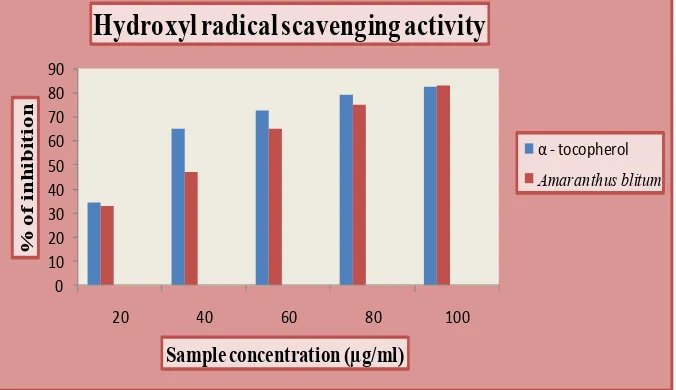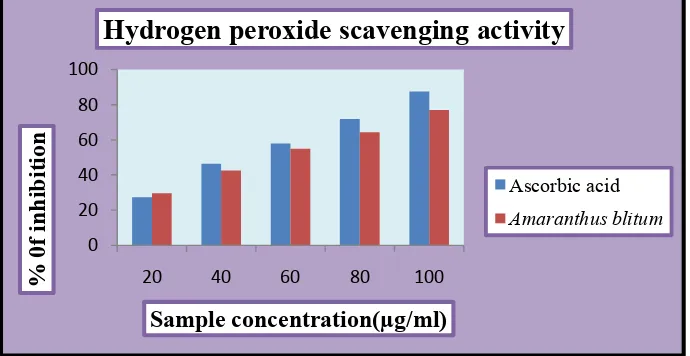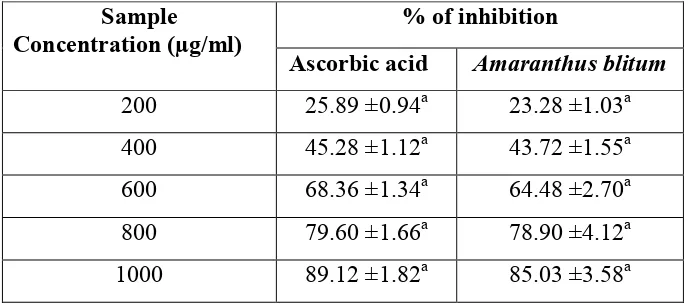FREE RADICAL SCAVEGIG ACTIVITY OF AMARATHUS BLITUM
Palaniswamy Saranya* & Dr. Kandasamy Gurusamy
Department of Biochemistry, Dr.N.G.P Arts and Science College, Dr.N.G.P Nagar, Kalappatti Road, Coimbatore-48, Tamilnadu, India.
Summary
Plants serve as a rich source of many novel biologically active compounds. Free radical stress leads to tissue injury and progression of disease conditions such as arthritis, hemorrhagic shock, diabetes, hepatic injury, aging and ischemia, reperfusion injury of many tissues, gastritis, tumour promotion, neurodegenerative diseases and carcinogenesis. Safer antioxidants suitable for long term use are needed to prevent or stop the progression of free radical mediated disorders. Many plants possess antioxidant ingredients that provided efficacy by additive or synergistic activities. Amaranthus blitum is used as a medicine against lung disorders. The antioxidant activity of ethanolic extract
of Amaranthus blitum was assessed by using DPPH assay, FRAP
assay, Reducing power assay, Superoxide, Nitricoxide, Hydroxyl, H2O2 radical scavenging activity and Lipid peroxidation inhibition
assay. The ethanolic extract showed inhibition in a dose dependant manner and the results were expressed as IC50. The antioxidant
components of the natural products constitute the major source of human health promotion and maintenance.
Key words: Amaranthus blitum, Free radicals, Antioxidant activity
*Corresponding author: Palaniswamy Saranya, Department of Biochemistry, Dr.N.G.P Arts and Science College,
Dr.N.G.P Nagar, Kalappatti road, Coimbatore-48, Tamilnadu, India.
Email: saranbiochemistry@gmail.com
Introduction
Plants produce a diverse range of bioactive molecules, making them a rich source of different types of medicines [1]. Plants have formed the basis of sophisticated traditional medicine systems that have been in existence for thousands of years and continue to provide mankind with new remedies. Medicinal plant therapy is based on the empirical findings of hundreds and possibly thousands of years of use [2].
Plants are potent biochemical factories and components of phytomedicine since times immemorial; man is able to obtain from them a wondrous assortment of industrial chemicals. Plants based natural constituents can be derived from any part of plant like bark, leaves, flowers, roots, fruits, seeds, etc (i.e.) any part of the plant may contain active components [3]. The beneficial medicinal effects of plant materials typically result from the combinations of secondary products present in the plant. The medicinal actions of plants are unique to particular plant species or groups are consistent with this concept as the combination of secondary products in a particular plant is taxonomically distinct [4].
Free radicals are fundamental to biochemical processes and represent an essential part of aerobic life and metabolism. The most common ROS include superoxide anion, hydrogen peroxide (H2O2), peroxyl radical (ROO-) and reactive hydroxyl radicals (OH-). The nitrogen
derived free radicals are nitric oxide (NO2), peroxy nitric anion (ONOO-). ROS have
implicated in over a hundred of disease states which range from arthritis and connective tissue disorders to carcinogenesis, aging and physical injury. In treatment of these diseases, antioxidant therapy has gained a prime position [5].
Amaranthus blitum spreads over the world from the tropics to temperate areas such as
Japan and Western Europe. The cultivated type probably originates from India where, still it is an important vegetable. The main use of Amaranthus blitum is as a cooked leaf vegetable. Vegetable Amaranthus in general are recommended as a good food with medicinal properties for young children, lactating mothers and for patients with fever, haemorrhage, anaemia and kidney complaint. The leaves are used to treat inflammations and boils. Amaranthus blitum is used as a medicine against lung disorders.This plant is said to be laxative and used in hepatic disorder and enlarge spleen. The current paper deals with the antioxidant activity of ethanolic extract of Amaranthus blitum using various in vitro models.
Materials and Methods
Plant material
The leaves of Amaranthus blitum was used for the studies. The plant was collected in the month of January from the surroundings of Tamilnadu, India. They were identified and authenticated by a Taxonomist. The leaf was washed, shade dried, powdered and stored in air tight containers separately under refrigeration.
Extraction of the plant material
Drugs
Chemicals used in this study were 1, 1-diphenyl-2-picrylhydrazyl (DPPH), Potassium ferricyanide, Trichloroaceticacid, Butylated Hydroxyl Anisole (BHA), Ascorbic acid, Phosphoric acid, Nitro blue tetrazolinium (NBT). All reagents used for the study were of analytical grade.
Antioxidant assay
DPPH radical scavenging assay
The free radical scavenging activity of the fractions was measured in vitro by 1, 1- diphenyl-2-picrylhydrazyl (DPPH) assay [6]. About 0.3 mM solution of DPPH in100% ethanol was prepared and 1 ml of this solution was added to 3.0 ml of the fraction dissolved in ethanol at different concentrations. The mixture was shaken and allowed to stand at room temperature for 30 min and the absorbance was measured at 517nm. The percentage scavenging inhibition was determined and was compared with that of ascorbic acid which was used as the standard. The percentage inhibition was calculated by
(Acontrol – Atest)
Inhibition (%) = ———————— x 100 Acontrol
Where Acontrol is the absorbance of the control reaction and Atest is the absorbance in the
presence of the sample of the extract. The antioxidant activity of the extract was expressed as IC50. The IC50 value was defined as the concentration (in µg/ml) of extract that inhibits the
formation of radicals by 50%.
FRAP (Ferric reducing antioxidant power) assay
The FRAP assay was done by the method of Pulido [7]. The assay mixture contained 2.5ml of 300mM acetate buffer at pH 3.6, 0.25ml of 10mM TPTZ solution in 40mM HCl, 0.25ml of 20mM FeCl3 and test substances in 0.1ml ethanol. The absorbance was measured after 30 min incubation at 593nm. All tests were run on triplicate and mean values were used to calculate EC1 values. EC1 is defined as concentration of an antioxidant having a ferric reducing
ability equivalent to that of 1mM ferrous salt.
itric oxide radical scavenging activity
Superoxide radical scavenging activity
Superoxide activity of the extract was determined by McCord and Fridovich method [9] which depends on light induced superoxide generation by riboflavin and the corresponding reduction of NBT. The assay mixture contained 0.3ml of different concentrations of the extract and 0.2ml ethylene diamine tetra acetic acid (6µM containing 3µg NaCN), 0.1ml nitro blue tetrazolinium (NBT) (50µM), 0.05ml riboflavin (2µM) and 2.35ml phosphate buffer (58mM, pH 7.8) to give a total volume of 3.0ml. The tubes were uniformly illuminated with an incandescent light for 15 min and the optical density was measured at 560nm. The percentage inhibition by the extract of superoxide production was evaluated by comparing the absorbance values of control and experimental tubes. The percentage inhibition was calculated as in DPPH radical scavenging activity.
Hydroxyl radical scavenging activity
Hydroxyl radical scavenging activity was measured according to the modified method of Halliwell [10]. The scavenging activity was measured by studying the competition between deoxyribose and the extract for hydroxyl radical generated from the Fe3+/ascorbate/H2O2
system. Stock solution of EDTA (1mM), FeCl3 (10mM), Ascorbic acid (1mM), H2O2 (10mM)
and deoxyribose (10mM) were prepared in distilled deionised water.
The assay was performed by adding 0.1ml EDTA , 0.01ml of FeCl3, 0.1ml of H2O2,
0.36ml of deoxyribose, 1.0ml of the extract (10-100µg/ml) dissolved in phosphate buffer (50mM pH 7.4) and 0.1ml of ascorbic acid in sequence. The mixture was then incubated at 37°C for 1hr. A 1.0ml portion of the incubated mixture was mixed with 1.0ml of 10%TCA and 1.0ml of 0.5% TBA to develop the pink chromogen measured at 532nm. The hydroxyl radical scavenging activity of the extract is reported as % inhibition of deoxyribose degradation.
Hydrogen peroxide scavenging activity [11]
A solution of hydrogen peroxide (40mM) was prepared in phosphate buffer (pH 7.4). Different concentrations (20- 100µg/ml) of the extract were added to a hydrogen peroxide solution (0.6ml, 40mM). Absorbance of hydrogen peroxide at 230nm was determined after 10min against a blank solution containing phosphate buffer without hydrogen peroxide. The percentage scavenging of hydrogen peroxide of the extract and standard compounds was calculated as in DPPH radical scavenging activity.
Determination of reducing power [12]
The reducing power of the extracts was determined according to the method of Oyaizu (1986). Various concentrations of the extracts (100-500µg/ml) in 1.0ml of deionised water were mixed with phosphate buffer (2.5ml, 0.2M, pH 6.6) and 1% Potassium ferricyanide (2.5ml). The mixture was incubated at 50°C for 20min. Aliquots of trichloroaceticacid (2.5ml) was added to the mixture, which was then centrifuged at 1000 rpm for 10min. The upper layer of solution (2.5ml) was mixed with distilled water (2.5ml) and a freshly prepared Fecl3 solution
Determination of lipid peroxidation inhibition activity [13]
Inhibition of lipid Peroxidation was determined by the thiobarbituric acid method. 0.1ml of different concentrations of the extract was incubated at 37°C with 25% (w/v) rat liver homogenate (0.1ml) containing Tris-HCl buffer (40mM, pH 7.0), 0.1ml KCl (30mM), 0.1ml ascorbic acid (0.06mM) and 0.1ml ferrous iron (0.16mM) in a total volume of 0.5ml for 1 hr. At the end of the incubation period , 0.4ml of the reaction mixture was treated with 0.2ml sodium dodecyl sulphate (8.1%), 1.5ml thiobarbituric acid (0.8%) and 1.5ml acetic acid (20%. pH 3.5). The total volume was then made up to 4.0ml by adding distilled water and kept in boiling water bath at 95°C for 1 hr. After the mixture had been cooled, 1.0ml distilled water and 5.0ml of butanol-pyridine mixture (15:1 v/v) were added. Following vigorous shaking, the tubes were centrifuged and absorbance of the upper layer containing the chromophore was read at 532nm. The percentage inhibition of lipid Peroxidation by the extract was determined by comparing the absorbance values of the control and experimental tubes.
Statistical analysis
Tests were carried out in triplicates. Statistical analysis was carried out using the statistical package SPSS version (10). Differences among the tested antioxidants were analysed by using one-way ANOVA. Values are expressed as the mean ± SD and differences between groups were considered to be significant if p<0.05.
Results and Discussion
ROS are responsible for the damage of cellular biomolecules such as proteins, enzymes, nucleic acids, lipids and carbohydrates and may adversely affect immune function [14]. Antioxidants interrupt the production of ROS and also play a key role to inactivate them [15].
1, 1-Diphenyl-2-picryl-hydrazyl (DPPH•) radical scavenging assay
DPPH is a stable free radical at room temperature and accept an electron or hydrogen radical to become stable diamagnetic molecule. The reduction capability of DPPH radicals was determined by the decrease in its absorbance at 517nm [16]. DPPH radicals react with suitable reducing agents, the electrons become paired off and the solution loses colour stochiometrically depending on the number of electrons taken up.
Table 1: Free radical scavenging activity of Amaranthus blitum by DPPH radical inhibition
Absorbance (517nm) Sample
Concentration (µg/ml)
Ascorbic acid Amaranthus blitum
20 48.1±0.31a 47.3±0.69a
40 61.7±0.61a 58.3±0.59a
60 89.7±0.42a 72.1±0.72a
80 94.1±0.72a 80.3±0.46a
100 95.8±0.65a 92.2±0.53a
Results are expressed as mean ± SD of the three parallel measurements.
The IC50 values of Amaranthus blitum were found to be 37.5µg/ml when compared to
the standard ascorbic acid whose IC50 value were found to 25.0µg/ml.
FRAP (Ferric Reducing Antioxidant Power) Assay
Ferric reducing antioxidant power (FRAP) measures the ability of antioxidants to reduce ferric 2, 4, 6-tripyridyl-s-triazine complex to intensively blue colored ferrous complex in acidic medium [17]. Hence any compound which is having redox potential lower than that of redox pair Fe (III)/Fe (II) can theoretically reduce Fe (III) to Fe (II).
Fig 1: Ferric reducing ability of Amaranthus blitum and standard ascorbic acid
FRAP assay
32 32,5 33 33,5 34 34,5 35 35,5
Ascorbic acid Amaranthus blitum
Samples (100µg/ml)
E
C1
v
a
lu
es
The tests were run in triplicate and mean values were used to calculate EC1 values. EC1
is defined as concentration of an antioxidant having a ferric reducing ability equivalent to that of 1mM ferrous salt.
The FRAP EC1 value of Amaranthus blitum was found to be 33.08µg/ml whereas the
standard vitamin C was found to be 35.00 µg/ml respectively.
Superoxide radical scavenging activity
Table 2: Superoxide radical scavenging activity of Amaranthus blitum and standard ascorbic acid
% of Inhibition
Sample
Concentration (µg/ml) Ascorbic acid Amaranthus blitum
10 34.01 ±1.05a 32.45 ±0.51a
20 47.20 ±0.06a 47.18 ±1.06a
30 65.36 ±0.09a 64.10 ±2.05a
40 82.30 ±0.10a 77.43 ±1.35a
50 93.41 ±1.62a 91.62 ±1.56a
Results are expressed as mean ± SD of the three parallel measurements.
SD values followed by common superscript letter (a) are significant at 5% level when compared to control.
The scavenging effects of the ethanolic extract on the superoxide radical of Amaranthus
blitum were found to be 91.62%. Increasing the sample concentration range from 10 to
50µg/ml, the scavenging effect also increased in the dose dependant manner.
The IC50 value of ethanolic extracts of Amaranthus blitum were found to be 25µg/ml
when compared to the standard ascorbic acid whose IC50 value were found to 21.5µg/ml at a
concentration of 50µg/ml.
itric oxide radical scavenging activity
Nitric oxide (NO) is a potent pleiotropic mediator of physiological processes such as smooth muscle relaxation, neuronal signalling, inhibition of platelet aggregation and regulation of cell mediated toxicity. It is a diffusible free radical which plays major roles as an effector molecule in diverse biological systems including neuronal messenger, vasodilation, antimicrobial and antitumor activities [19].
Table 3: itricoxide radical scavenging activity of Amaranthus blitum and standard ascorbic acid
% of inhibition Sample
Concentration (µg/ml) Ascorbic acid Amaranthus blitum
20 36.86 ±0.50a 34.09 ±2.31a
40 59.76 ±2.10a 56.15 ±0.50a
60 69.52 ±2.54a 65.23 ±2.80a
80 76.59 ±0.02a 74.16 ±2.87a
100 90.40 ±2.60a 89.89 ±3.03a
Results are expressed as mean ± SD of the three parallel measurements.
SD values followed by common superscript letter (a) are significant at 5% level when compared to control.
Amaranthus blitum (89.89%) showed nitricoxide radical scavenging activity at the
concentration of 100µg/ml. The IC50 value of Amaranthus blitum was 36µg/ml whereas
standard ascorbic acid showed an IC50 value of 32µg/ml as a positive control.
Hydroxyl radical scavenging activity
The most reactive of the ROS that attacks almost every molecule in the body is the hydroxyl radical. It initiates the peroxidation of cell membrane lipids [21] yielding malondialdehyde, which is mutagenic and carcinogenic [22]. Hydroxyl radicals are formed in vivo from water by high-energy irradiation or from H2O2 in a metal-catalyzed process [23].
Fig. 2: Hydroxyl radical scavenging activity of Amaranthus blitum and standard α - tocopherol.
Amaranthus blitum showed inhibition with a value of 83.20% at concentration of
100µg/ml when compared to α - tocopherol with the value of 82.61%. The IC50 values showed
an inhibition percentage of 36µg/ml for Amaranthus blitum at a concentration of 100µg/ml.
0 10 20 30 40 50 60 70 80 90
20 40 60 80 100
%
o
f
in
h
ib
it
io
n
Sample concentration (µg/ml)
Hydroxyl radical scavenging activity
α - tocopherol
H2O2 scavenging activity assay
Hydrogen peroxide is a weak oxidizing agent and can inactivate a few enzymes directly, usually by oxidation of essential thiol (-SH) groups. Hydrogen peroxide can cross cell membranes rapidly, once inside the cell, H2O2 can probably react with Fe2+ and possibly Cu2+
ions to form hydroxyl radical and this may be the origin of many of its toxic effects [24]. The decomposition of H2O2 by Amaranthus blitum may result from its antioxidant and free radical
scavenging activity.
Fig. 3: Hydrogen peroxide scavenging activity of Amaranthus blitum and standard ascorbic acid.
0 20 40 60 80 100
20 40 60 80 100
%
0
f
in
h
ib
it
io
n
Sample concentration(µg/ml)
Hydrogen peroxide scavenging activity
Ascorbic acid
Amaranthus blitum
The plant extract and standard ascorbic acid exhibited hydrogen peroxide in a dose dependant manner. The IC50 value of Amaranthus blitum was found to be 54µg/ml at
concentration of 100µg/ml.
Lipid Peroxidation inhibition activity
In order to determine if the extract were capable of reducing in vitro oxidative stress, lipid peroxidation was assessed by means of an assay that determines the production of malondialdehyde and related compounds in rat liver homogenates. Malondialdehyde is one of the major degradation products of lipid peroxidation, which has been extensively studied and measured as a marker for oxidative stress [25].
Thiobarbituricacid reactive species (TBARS) are produced as by-products of lipid peroxidation that occurs in the hydrophobic core of biological membranes [26]. Therefore lipid Peroxidation has been identified as one of the basic reactions involved in oxygen free radical induced cellular damages [27] and plays an important role in the pathogenesis of several diseases.
Table 4. Lipid peroxidation inhibition activity of ethanolic extract of Amaranthus blitum
and standard ascorbic acid.
% of inhibition Sample
Concentration (µg/ml)
Ascorbic acid Amaranthus blitum
200 25.89 ±0.94a 23.28 ±1.03a
400 45.28 ±1.12a 43.72 ±1.55a
600 68.36 ±1.34a 64.48 ±2.70a
800 79.60 ±1.66a 78.90 ±4.12a
1000 89.12 ±1.82a 85.03 ±3.58a
Results are expressed as mean ± SD of the three parallel measurements.
SD values followed by common superscript letter (a) are significant at 5% level when compared to control.
The ethanolic extract of Amaranthus blitum prominently inhibited the formation of MDA and exhibited significant antilipid peroxidative effect. The percentage inhibition of lipid peroxidation of Amaranthus blitum is 85.03±3.58 at a concentration of 1000µg/ml were observed. The IC50 value of standard ascorbic acid as positive control was 420µg/ml.
Reducing power assay
The reducing ability of a compound generally depends on the presence of reductones [28] which exhibit antioxidative potential by donating a hydrogen atom for breaking the free radical chain [29]. The reducing ability of ethanolic extract of Amaranthus blitum is illustrated in the table 5.
Table 5: Reductive ability of Amaranthus blitum and standard ascorbic acid.
Absorbance (700nm) Sample
Concentration (µg/ml) Ascorbic acid Amaranthus blitum
10 0.15 ±0.01a 0.12 ±0.06a
20 0.30 ±0.03a 0.23 ±0.03a
30 0.45 ±0.02a 0.32 ±0.02a
40 0.60 ±0.04a 0.42 ±0.05a
50 0.75 ± 0.05a 0.59 ±0.04a
Results are expressed as mean ± SD of the three parallel measurements.
SD values followed by common superscript letter (a) are significant at 5% level when compared to control.
Conclusion
The Reactive Oxygen species or oxidants, which are formed in the human body due to exogenous and endogenous factors, are found to be responsible for many diseases. Day by day, a lot of research have shown the potential of phytochemical antioxidants as health benefactors because of their ability to neutralize free radicals, reactive oxygen species and oxidants responsible for the onset of cell damage.
The present study was undertaken to establish the free radical scavenging activity of the
Amaranthus blitum. The ethanolic extract showed significant free radical scavenging activity when compared to other well characterized, standard antioxidant systems in vitro. However, the components responsible for antioxidant activity of Amaranthus blitum are currently unclear. Therefore, it is suggested that further work be performed for isolation and identification of the antioxidant components of Amaranthus blitum.
Interest in the search for new natural antioxidants has grown dramatically over the past years because reactive oxygen species (ROS) production and oxidative stress have been shown too linked to ageing related illnesses [30] and a large number of other illnesses.
References
1. Hennebelle T, Sahpaz HS, Joseph F, et al. Phenolics and iridoids of Lippia alba. Natural Product Sciences 2006; 1:727-730.
2. Heinrich M, Barnes J, Gibbons S. Fundamentals of Pharmacognosy and Phytotheraphy, Elsevier science Ltd, 2009:107-15.
3. Zétola M, Lima TC, Sonaglio CS. Activities of liquid and spray-dried extracts from
Lippia alba Verbenaceae (Brazilian false Melissa). Journal of Ethnopharmacology 2002;
82:207-215.
4. Naznin A, Hasan N. (2009). In vitro Antioxidant Activity of Methanolic Leaves and Flowers Extracts of Lippia alba. Research Journal of Medicine and Sciences 2009; 4(1):107-110.
5. Sangameswaran B, Balakrishnan BR, Deshiraj C, et al. In vitro antioxidant activity of roots of Thespesia lampas dalz and Gibs. Pak. J. Pharm. Sci. 2009; 22(4):368-372.
6. Yaushisakono A. DPPH free radical scavenging activity of medicinal plant extract. Biochemistry and Biophysics 1978; 136(1):189-195.
7. Pulido R, Bravi L, Saara-Calixto F. Antioxidant activity of dietary polyphenols as determined by a modified Ferric Reducing / Antioxidant power assay. J. Agric. Food. Chem. 2000; 48:3396-3402.
8. Govindarajan R, Rastogi S, Vijayakumar M. Bio. Pharm. Bull. 2003; 26:1424-1427. 9. McCord and Fridovich I. Superoxide dismutase: An enzymatic function for
erythrocuprein. Journal of biological chemistry 1969; 244: 6049-55.
10.Halliwell B, Murcia MA, Chirico S, et al. Free radicals and antioxidants in food and in vivo: what they do and how they work. Crit. Rev. Food Sci. Nutr. 1995; 35: 7-20.
11.Ilhami GI, Haci AA, Mehmet C. Chem. Pharm. Bull. 2005; 53(3):281-285.
12.Oyaizu M. Studies on product of browning reaction prepared from glucose amine. Jpn. J. Nutr. 1986; 44:307-315.
14.Ganapathy S, Chandrasekhar VM, Chitme HR, Lakshmi Narsu M. Free radical scavenging activity of gossypin and nevadensin: An in vitro relation. Indian journal of pharmacology 2007; 39: 281-283.
15.Nilsson J, Stegmark R, Akesson B. Total antioxidant capacity in different pea (Pisum sativum) varieties after blanching and freezing. Food chem. 2004; 86:501-7.
16.Liao H, Banbury LK, Leach DN. Antioxidant activity of 45 Chinese herbs and the relationship with their TCM characteristics. eCAM 2008; 5:429-34.
17.Huang D, Ou B, Prior RL. The Chemistry behind Antioxidant Capacity Assays. J. Agric. Food Chem. 2005; 53:1841-1856.
18.Agbora R, Gupta D, Chawla R, et al. Radioprotection by plant products: Present status and future prospects. Phytotheraphy. Res. 2005; 19:1-22.
19.Hagerman AE, Riedl KM, Jones GA. High molecular weight plant polyphenolics (tannins) as biological antioxidants. J. Agric. And Food Chem. 1998; 46:1887-1892. 20.Re R, Pellegrini N, Proteggente A, et al. Antioxidant activity applying an improved ABTS
radical cation decolourization assay. Free Radical Bio Med. 1999; 26:1231–7.
21.Halliwell B. Reactive oxygen species in living systems: source, biochemistry and role in human disease. Am. J. Med. 1991; 91:14 - 22.
22.Miyake T, Shibamoto T. Antioxidant activities of natural compounds found in plants. J Agric Food Chem. 1997; 45:1819- 22.
23.Cheeseman KH, Slater TF. An introduction to free radical biochemistry. Brit Med Bull. 1993; 49:481- 93.
24.Halliwell B. The role of oxygen radicals in human disease, with particular reference to the vascular system. Haemostasis 1993; 23(1):118-126.
25.Janero DR. Malondialdehyde and thiobarbituric acid reactivity as diagnostic indices of lipid peroxidation and peroxidative tissue injury. Free Radic Biol Med. 1990; 9:515–540. 26.Fraga C, Leibovitz B, Tappel A. Halogenated compounds as inducers of lipid
peroxidation in tissue slices. Free Radical Res. 1987;3:119–123.
27.Halliwell B. The chemistry of free radicals. Toxicology & Industrial Health 1993;9:1-21. 28.Badmus M. Phytochemicals and in vitro antioxidant potentials of defatted Methanolic
extract of Holarrhena floribunda leaves. African Journal of Biotechnology 2010; 9(3):340-346.
29.Gordon MH. The mechanism of the antioxidant action in vitro. In: Hudson BJF. (ed), Food Antioxidant. Elsevier, 1990; 1-18.
